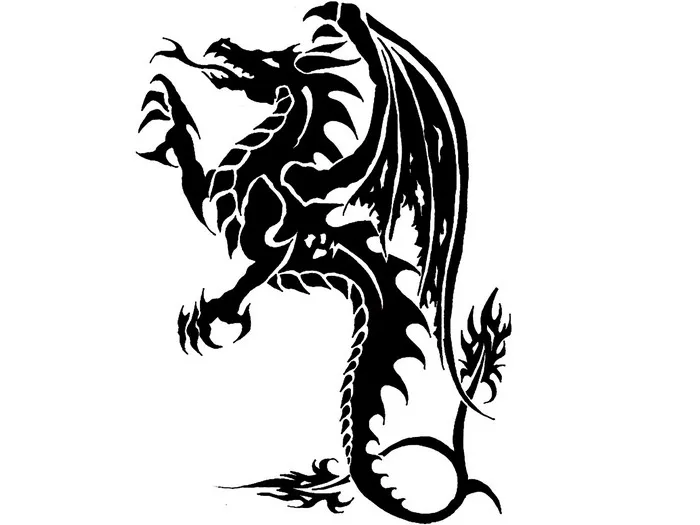Dragons, mythical creatures that have captivated human imagination for centuries, continue to inspire awe and fascination in contemporary culture. Among the various elements of dragon iconography, the claws stand out as potent symbols laden with meaning and significance. Whether in Asian or European traditions, the depiction of dragon claws in tattoos carries deep cultural, symbolic, and aesthetic connotations. In this comprehensive exploration, we delve into the symbolism of dragon claws across different cultural contexts, elucidate the types of dragon tattoos, and uncover the profound meanings associated with them.
Symbolism of Dragon Claws:
The claws of a dragon serve as powerful symbols in numerous cultural narratives, embodying traits such as power, strength, and protection. In both Asian and European mythologies, dragon claws are often portrayed as formidable weapons capable of inflicting both destruction and safeguarding against malevolent forces.
Asian Perspective:
In Asian cultures, particularly in China, dragons hold a revered status as symbols of auspiciousness and vitality. The significance of dragon claws is deeply ingrained in the rich tapestry of Chinese mythology, where dragons are revered as celestial beings associated with natural phenomena and divine attributes.
The portrayal of dragon claws in Chinese tradition reflects the multifaceted symbolism attributed to these mythical creatures. Dragons, often depicted as benevolent beings, are revered for their role as guardians of the natural world. Their claws symbolize authority over elements such as rain, thunder, and lightning, signifying their control over the forces of nature.
Moreover, dragon claws are emblematic of prosperity, good fortune, and protection in Chinese culture. It is believed that invoking the image of dragon claws through tattoos or other forms of art can attract positive energy and ward off evil spirits. Thus, dragon claw tattoos are not merely decorative but also serve as talismans of luck and blessings.
Common Chinese Dragon Tattoos:
Within the realm of Chinese dragon tattoos, several distinct motifs featuring dragon claws have emerged, each carrying its own symbolic significance:
1. Spiritual Dragon (Shenlong): This revered dragon embodies virtues such as stability, faith, and holiness. Often depicted with elongated serpentine bodies and intricate claws, Shenlong symbolizes the pursuit of truth and enlightenment.
2. Winged Dragon: As masters of the skies, winged dragons are associated with rains and floods, exerting control over these elemental forces. Their claws, depicted in tattoo art, symbolize authority and dominance over natural phenomena.
3. Celestial Dragon (Tianlong): Residing in the heavens, Tianlong serves as a celestial guardian, offering shelter and protection against malevolent forces. The depiction of its claws in tattoos signifies the dragon’s role as a benevolent protector and harbinger of good fortune.
4. Coiling Dragon (Panlong): With its association with the vast oceans, Panlong symbolizes the mysteries of the deep and the forbidden realms. Its claws, depicted in tattoo designs, represent the untamed forces of nature and the balance between chaos and order.
European Perspective:
In contrast to the benevolent portrayal of dragons in Asian cultures, European depictions often emphasize the menacing and malevolent aspects of these mythical creatures. European dragons, characterized by their massive size, formidable claws, and ability to breathe fire, are often depicted as antagonistic forces that must be overcome through heroism and valor.
The claws of European dragons symbolize not only their physical prowess but also their malevolent nature and the imminent threat they pose to humanity. In medieval European folklore, dragons are often depicted as hoarding treasures, with their claws serving as formidable weapons to protect their coveted possessions.
Types of Dragon Tattoos:
Dragon tattoos come in various forms and styles, each influenced by cultural traditions and artistic interpretations. While Asian and European dragons share certain commonalities, such as their reptilian appearance and association with power, they also exhibit distinct characteristics that differentiate them from one another.
Asian Dragon Tattoos:
Asian dragon tattoos, particularly those inspired by Chinese mythology, are characterized by their serpent-like bodies, elongated claws, and symbolic motifs. These tattoos often depict dragons in dynamic poses, symbolizing their celestial prowess and auspicious qualities.
The portrayal of Asian dragons in tattoos emphasizes their role as benevolent guardians and bringers of prosperity. Whether coiling around celestial orbs or soaring amidst auspicious clouds, these dragon tattoos exude a sense of majesty and mystique.
European Dragon Tattoos:
In contrast, European dragon tattoos evoke a sense of awe and fear, reflecting the ominous nature of these mythical creatures in Western folklore. European dragons are often depicted with massive wings, sharp claws, and fearsome visages, embodying the archetype of the menacing beast that must be vanquished by the hero.
European dragon tattoos often incorporate elements of medieval heraldry and Gothic art, featuring intricate details and dark, foreboding imagery. From fierce dragons breathing fire to stoic guardians clutching their hoarded treasures, these tattoos exude a sense of danger and adventure.
Additional Symbolism:
Beyond their cultural and mythological associations, dragon claws in tattoos carry additional layers of symbolism, representing themes such as battle, fearlessness, and power. The image of a dragon’s claw clutching a semi-precious gem, such as a pearl, symbolizes wealth, wisdom, and the pursuit of enlightenment.
In conclusion, dragon tattoos featuring claws serve as powerful symbols that transcend cultural boundaries and historical epochs. Whether inspired by Asian or European traditions, these tattoos embody the timeless allure of dragons as mythical beings imbued with cosmic significance. By understanding the symbolism of dragon claws in tattoos, we gain insight into the profound meanings that these mythical creatures hold in the collective imagination of humanity.
In essence, dragon claw tattoos are not merely decorative adornments but potent symbols that resonate with themes of power, protection, and transcendence. Whether emblazoned on skin or depicted in art, the claws of a dragon serve as enduring reminders of humanity’s eternal fascination with the mythical and the majestic.

